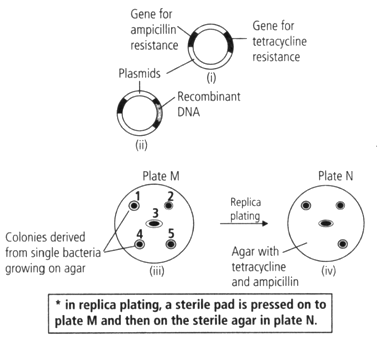Stirred-tank bioreactors have advantages over shake flasks because they

Important Questions on Biotechnology: Principles and Processes
(i) Taq polymerase extends the primers using the nucleotides provided in the reaction.
(ii) Antibiotic resistance genes are considered as desirable genes in recombinant DNA technology.
(iii) DNA fragments are separated according to their charge only, in agarose gel electrophoresis.
(iv) Transformation is a procedure through which a piece of DNA is integrated into the genome of a host bacterium.
(v) To produce higher yields of a desired protein, host cells can be multiplied in a continuous culture.
(vi) Downstream processing is one of the steps of polymerase chain reaction.
(i) When the transformed cells on agar plates containing ampicillin are spread, both transformed and untransformed cells will grow.
(ii) Restriction enzymes are used in isolation and separation of DNA from other macromolecules.
(iii) Downstream processing is one of the steps of rDNA technology.
(iv) Disarmed pathogen vectors are also used in the transfer of rDNA into the host.
| Column I | Column II | ||
|---|---|---|---|
| Kary Mullis | Father of genetic engineering | ||
| Paul Berg | Nobel Prize for the discovery of restriction endonucleases | ||
| Stanley Cohen and Herbert Boyer | Developed polymerase chain reaction | ||
| Arber, Smith and Nathan | Isolated an antibiotic resistant gene from a plasmid of the bacterium Salmonella typhimurium |
(i) _____ is a natural polymer extracted from _____.
(ii) The DNA fragments purified by gel electrophoresis are used in constructing _____ by joining them with _____.
(iii) The ligation of alien DNA is carried out at a _____ present in one of the two _____ in a plasmid vector.
(iv) _____ enzyme remains active during the high temperature induced denaturation of ds DNA.
(v) DNA fragments are resolved according to their _____ through _____ in agarose gel electrophoresis.
Four mutant strains of bacteria all require substance to grow (each strain is blocked at one step in the biosynthesis pathway). Four plates were prepared with minimal medium and a trace of substance to allow a small amount of growth of mutant cells. On plate , mutant cells of strain were spread over entire surface of the agar to form a thin lawn of bacteria. On plate , the lawn was composed of mutant cells of strain and so
on. On each plate, cells of each of the four mutant types were inoculated over the lawn, as indicated in the figure by the circles. Dark circles indicate excellent growth. A strain blocked at a later step in the substance metabolic pathway accumulates intermediates that can 'feed' a strain blocked at an earlier step.

What is the order of genes in the metabolic pathway for synthesis of substance
The figure shows the restriction enzyme cutting sites in wild type and mutant gene.

If a radioactively labelled probe (that hybridizes at a sequence close to is used for detecting the presence of fragments after gel electrophoresis and Southern blotting, which of the following band patterns will your expect?
Note :wild type mutant
Analyse the given diagram which shows steps involved in the procedure of selecting transformed bacteria.

Identify the bacterial colony which has undergone transformation?
